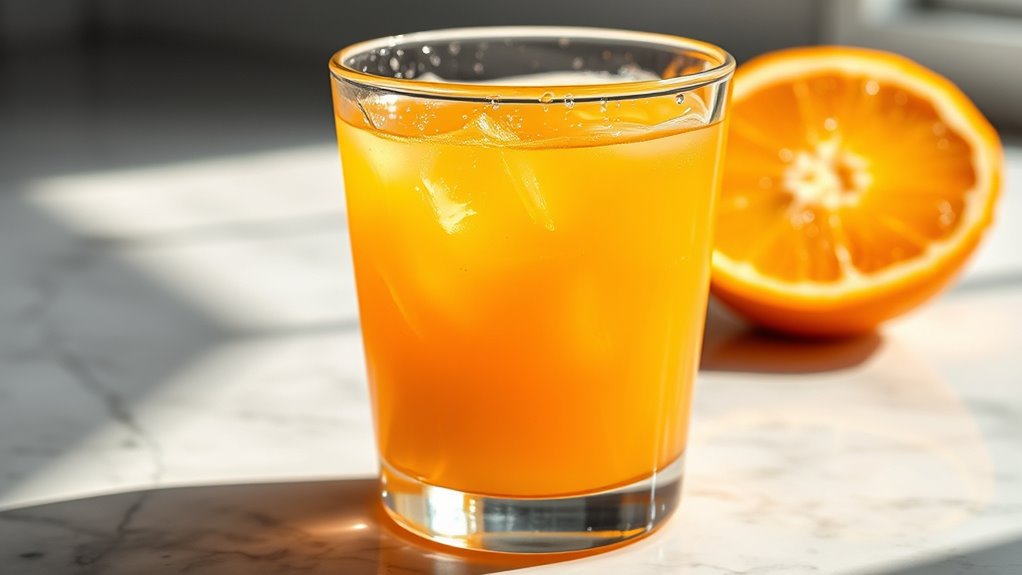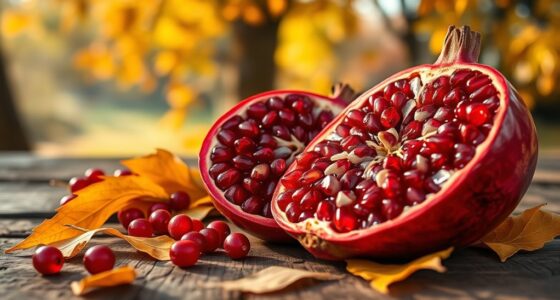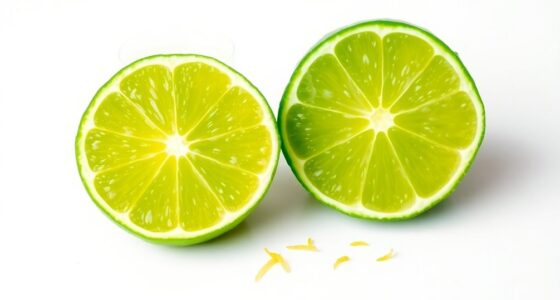When choosing orange juice, you’ll notice varying pulp levels and flavors to match your taste and health preferences. Some prefer pulp-rich juice for added fiber and a fuller texture, while others opt for pulp-free for a smooth sip. You can also find options with more natural sweetness or tartness, depending on the orange variety and processing method used. Exploring these styles helps you enjoy orange juice exactly how you like it—keep going to discover more options.
Key Takeaways
- Pulp levels range from pulp-free to high-pulp, affecting texture and mouthfeel.
- Pulp-rich juices offer more fiber and a robust, authentic citrus flavor.
- Pulp-free options provide a smooth, consistent taste preferred for quick consumption.
- Different orange varieties and processing methods influence the juice’s flavor profile and pulp content.
- Consumers can choose their preferred style based on texture, flavor, and health benefits.

Orange juice comes in a variety of styles, each offering a unique flavor and texture experience. When choosing your favorite, you’ll notice differences in pulp levels, which directly influence both the taste and the health benefits you receive. Pulp-rich orange juice contains more fiber, which aids digestion and helps keep you full longer, making it a smart choice if you’re after added health benefits. On the other hand, pulp-free options provide a smoother, more consistent flavor that some prefer for their morning routine or when you want a quick, invigorating drink without the chewy texture. As you explore these styles, you’ll find that the flavor variations are substantial—some juices highlight the natural sweetness of the fruit, while others have a tangy, more tart profile, depending on the orange variety and processing methods used. Additionally, understanding the different processing methods can help you select juices that retain more of the fruit’s natural nutrients and flavors. If you’re focusing on health benefits, you might lean toward pulpy orange juice, as the fiber helps regulate blood sugar levels and supports a healthy digestive system. Pulp also contains antioxidants and phytochemicals that can boost your immune system and reduce inflammation. Conversely, if you’re sensitive to pulp or simply prefer a cleaner mouthfeel, the pulp-free versions still deliver the essential vitamins like vitamin C and folate, which are essential for immune health and skin vitality. No matter what style you choose, you’re still getting the core nutritional benefits that make orange juice a nutritious beverage.
Flavor variations are another key factor to contemplate. Some brands produce concentrated orange juice, which they reconstitute with water, offering a more uniform flavor but sometimes sacrificing the fresh, vibrant taste of freshly squeezed juice. Others use high-pressure processing to preserve more of the fruit’s natural flavor and nutrients, giving you a richer, more authentic experience. You might prefer a juice made from Valencia oranges for a sweeter, milder taste, or opt for varieties like blood oranges that introduce a hint of berry-like sweetness and a striking color. The different styles and flavor variations allow you to tailor your orange juice experience, whether you’re after a tangy, zesty kick or a mellow, sweet sip. Being aware of the processing methods can help you choose juices that align with your preferences for freshness and nutrient retention.
Ultimately, the style of orange juice you select depends on your taste preferences and health goals. Pulp-rich options maximize fiber and health benefits, while pulp-free varieties offer a smooth, consistent flavor. The multitude of flavor variations across brands and orange types means you can always find a style that suits your palate. As you experiment, you’ll discover that there’s no one-size-fits-all—each style offers its own unique experience, making your daily orange juice routine both enjoyable and nourishing.
Frequently Asked Questions
How Does Pulp Affect Orange Juice Shelf Life?
Pulp can slightly reduce orange juice shelf life because it promotes pulp fermentation, which accelerates spoilage. You should store juice with pulp properly to preserve its freshness longer. Removing pulp or pasteurizing can help control fermentation and extend shelf life. Ultimately, pulp impacts how quickly the juice deteriorates, so managing pulp levels and storage conditions is key for shelf life preservation.
Are Pulp-Free Juices More Nutritious?
Pulp-free juices aren’t necessarily more nutritious, but pulp does add nutritional value, including fiber, vitamins, and antioxidants. If you prefer a smoother texture, pulp-free juice suits your taste, but you might miss out on some benefits. Ultimately, your pulp texture preferences influence your choice, so consider what nutrients matter most to you when selecting between pulp-free and pulpy orange juice.
What Brands Offer the Best Pulp Options?
You’ll find that brands like Tropicana, Simply Orange, and Florida’s Natural offer the best pulp options, giving you a variety of pulp textures to suit your preference. Tropicana provides a good balance of pulp, while Simply Orange offers a smoother experience with some pulp for texture. Florida’s Natural gives you a more natural, pulpy feel. Explore their brand variety to discover which pulp level you prefer most.
Does Pulp Level Impact Sugar Content?
Yes, pulp level impacts sugar content because higher pulp content typically means more natural sugars are retained from the oranges. Pulp content influences sugar variation; juice with more pulp often has a slightly higher sugar level, giving it a richer, more authentic flavor. When choosing your orange juice, consider that pulp content can subtly affect the sweetness, so select according to your taste preferences for a balanced, enjoyable drink.
How Is Pulp Removed During Processing?
Pulp is pulled out using precise processing techniques. You’ll find methods like straining, sedimentation, and centrifugation, which swiftly separate pulp from juice. Straining pushes pulp through sieves, sedimentation allows pulp to settle, and centrifugation spins pulp away at high speeds. These processing techniques efficiently eliminate pulp, creating smooth juice with minimal pulp particles, so you get a clear, pulp-free experience or a pulp-perfect sip depending on your preference.
Conclusion
So, next time you grab a glass of orange juice, remember that pulp levels can really change your experience. Some say pulp adds natural fiber and flavor, making it healthier and tastier, while others prefer smooth juice for a revitalizing sip. The truth? It’s all about your personal preference. Whether you like it pulpy or not, just enjoy your juice knowing it’s a simple way to boost your day with a burst of citrus goodness.
Cindy thoroughly researches juicing trends, techniques, and recipes to provide readers with practical advice and inspiration. Her writing style is accessible, engaging, and designed to make complex concepts easy to understand. Cindy’s dedication to promoting the advantages of juicing shines through her work, empowering readers to make positive changes in their lives through the simple act of juicing.
















